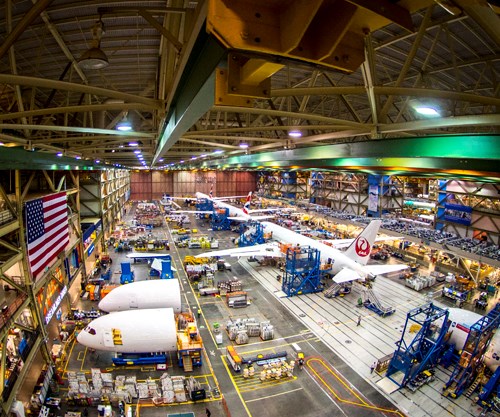An aerocomposites wish list
Boeing R&T fellow Tom Tsotsis offers his vision of how design and manufacture of composite parts and structures might evolve in the aerospace industry.

Dr. Thomas Tsotsis, technical fellow, materials and process technology at Boeing Research & Technology (Huntington Beach, CA, US), was a keynote speaker at the Society of Plastics Engineers’ (SPE) ANTEC conference in Anaheim, CA, on May 10. Tsotsis’ presentation title was simple: “A path for composites.” It might also have been titled, “My composites wish list.”
Admittedly, the complete composites manufacturing strategy of a company as big as Boeing cannot be ascribed to one person at Boeing, but Tsotsis’ long experience with aerocomposites does give his words weight, and what he had to say was interesting.
First, he reviewed the history of prepreg use, noting that it became the preferred material form because it enabled manufacturers to achieve consistent resin matrix ratios in finished products. Prepregs have also been well qualified and are well supported with material characterization data. He also noted that prepregs are difficult to form in to complex shapes, have a limited working life, must be kept frozen when not in use, and require expensive “monument” equipment — ATLs and autoclaves — that tend to become workflow bottlenecks.
Liquid molding, on the other hand, he said, offers fabricators the ability to use 3D preforms, braids and weaves; allows more material flexibility to meet a variety of end-use requirements; eliminates the use of an autoclave; and requires no freezer. Downsides? Fiber/resin ratios are more difficult to control with liquid molding, composites made via liquid molding are not as well qualified, and liquid molding processes require additional quality control steps that prepregs don’t require. Further, he admitted that companies like Boeing have invested millions of dollars in autoclaves, thus their use is, in many ways, imperative.
In short, said Tsotsis, he said he believes the aerospace industry needs to “get out of the prepreg box” and look more seriously at new chemistries, collaborate to develop reliable design models, increase automation, reduce assembly costs, more proactively address environmental concerns, and more effectively leverage knowledge from other composites end markets.
From the design side, Tsotsis said he would like to see more innovation in chemistry so that resins can be tailored to designs, rather than designs tailored to chemistries, which he believes is the current modus operandi. In addition, he said he would like to see molecular dynamics tools better developed and definitively linked to verifiable test data. And model develpment on the whole, he said, is too siloed and needs to be addressed more cooperatively and collaboratively with suppliers, OEMs and researchers. Finally, he said, “modeling of strength needs a quantum improvement to be truly useful.”
On the aerocomposites manufacturing floor, Tsotsis said, quality control drives everything, and because of that, process control is paramount. But, unlike the automotive industry, where quality is measured by process consistency, aerospace relies on 100% inspection of finished parts, regardless of process quality. The difference, of course, are the risks involved, and in aerospace there is no room for error.
Tsotsis ended his presentation with a reminder of the value of change, and a desire for a willingness to see technical maturation continue: “Just because we’ve done something that way does not mean it’s the best way.”
Related Content
Otto Aviation launches Phantom 3500 business jet with all-composite airframe from Leonardo
Promising 60% less fuel burn and 90% less emissions using SAF, the super-laminar flow design with windowless fuselage will be built using RTM in Florida facility with certification slated for 2030.
Read MoreIndustrializing additive manufacturing in the defense/aerospace sector
GA-ASI demonstrates a path forward for the use of additive technologies for composite tooling, flight-qualified parts.
Read MorePlant tour: Airbus, Illescas, Spain
Airbus’ Illescas facility, featuring highly automated composites processes for the A350 lower wing cover and one-piece Section 19 fuselage barrels, works toward production ramp-ups and next-generation aircraft.
Read MorePlant tour: Aernnova Composites, Toledo and Illescas, Spain
RTM and ATL/AFP high-rate production sites feature this composites and engineering leader’s continued push for excellence and innovation for future airframes.
Read MoreRead Next
Ceramic matrix composites: Faster, cheaper, higher temperature
New players proliferate, increasing CMC materials and manufacturing capacity, novel processes and automation to meet demand for higher part volumes and performance.
Read MoreUltrasonic welding for in-space manufacturing of CFRTP
Agile Ultrasonics and NASA trial robotic-compatible carbon fiber-reinforced thermoplastic ultrasonic welding technology for space structures.
Read MoreNext-gen fan blades: Hybrid twin RTM, printed sensors, laser shock disassembly
MORPHO project demonstrates blade with 20% faster RTM cure cycle, uses AI-based monitoring for improved maintenance/life cycle management and proves laser shock disassembly for recycling.
Read More












